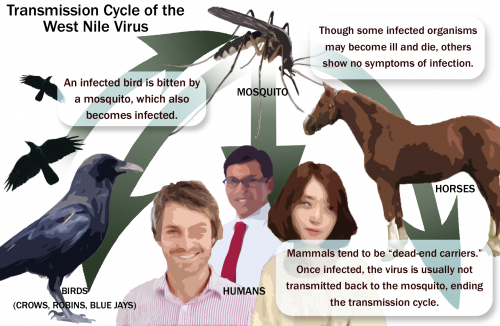Accession West Nile Virus in San Gabriel Valley
ELTON HO
Staff Writer
Each year, summer features the advent of the mosquito season, with the bug population peaking in August and September. Although they are a common annoyance, many people may not be aware that the U.S. encounters alarming annual outbreaks of the West Nile virus (WNV) that is transferred by mosquitoes. With the discovery of the virus’s presence in the San Gabriel Valley (SGV), officials are requesting that citizens do their best to avoid infection and prevent its spread.
The SGV Mosquito and Vector Control District confirmed WNV activity in the cities of Arcadia, Irwindale and Monterey Park on Aug. 27. Positive samples were found in both actual mosquitoes and “Sentinel Chicken Flocks,” groups of chickens carefully maintained to allow the tracing of virus activity. Dead birds containing the virus were later detected in neighboring cities like Azusa, Covina, Glendora, La Verne, Monrovia and West Covina.
As of Sept. 17, 150 human cases of WNV, including 6 deaths, have been reported in California by the national Centers of Disease Control and Prevention (CDC).
Neither a vaccine nor a treatment method for WNV has been developed. One thing to keep in mind is that WNV is transmitted solely through bites from infected mosquitoes, except in rare cases.
“Preventing West Nile virus from making you sick is as simple as preventing mosquito bites,” SGV Mosquito & Vector Control District manager Kenn Fujioka said in a press release.
Bites can be avoided in several ways. The National Institute of Health (NIH) recommends staying indoors from dusk to dawn, the time in which mosquitoes are most active. Also, screen covers on windows and doors keep insects outside of the house, and the correct use of a simple insect repellent will drive them away.
According to CDC, about 80 percent of people infected with WNV will actually display few to no symptoms. The other 20 percent will develop conditions such as fever, headaches, joint pains, rashes, vomiting and diarrhea 3 to 14 days after being bitten. Minor symptoms fade after 5 to 10 days, but fatigue and general weakness may persist for weeks or months. In very rare cases, the virus may cause a severe, even fatal, neurological disease. The elderly and those with weak immune systems or health conditions have a higher chance of being strongly affected.
According to NIH, WNV first appeared in the U.S. in 1999. The amount of reported cases in the country has fluctuated throughout the years, with 2012 having a particularly high number at 5,674.
“I never knew about West Nile [being present in the U.S.]. I wish there were some kind of warning sent out to the residents in the contaminated area. I am scared about the virus, even if it mostly consists of normal cold symptoms, [since it is incurable],” sophomore Samantha Lin said.
The community plays a part in preventing the spread of WNV. Bodies of standing water are breeding grounds for mosquitoes, so SGV’s Mosquito Control District asks that they be removed or regularly cleaned. In addition, unnaturally large amounts of dead birds may be a sign of virus circulation and should be reported to local authorities immediately.
